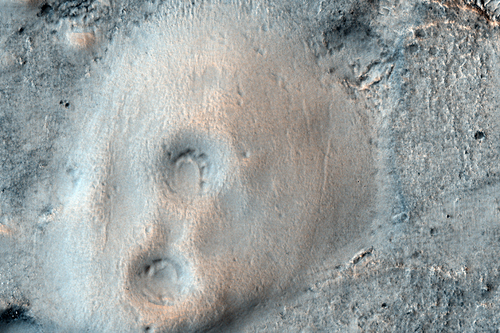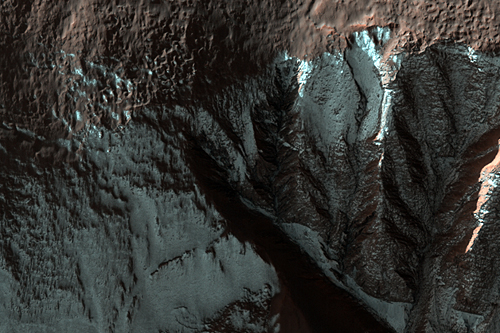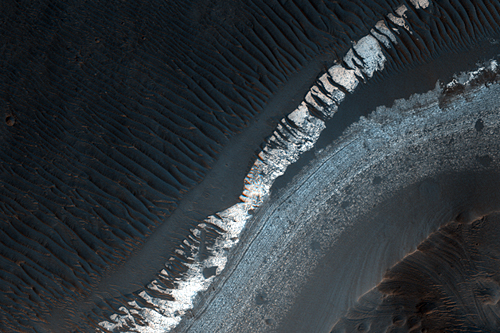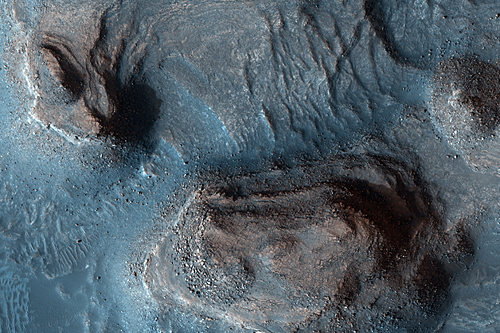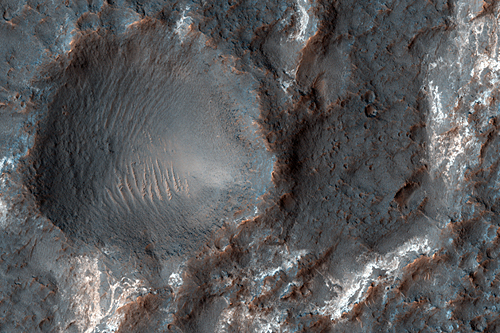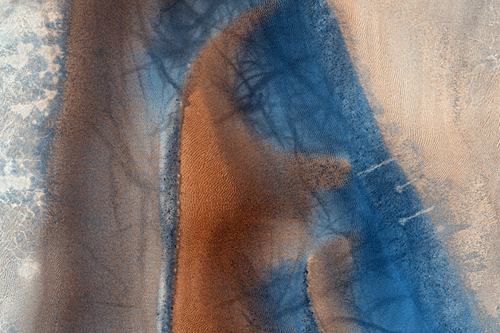Mounds in Acidalia Planitia (ESP_017950_2205)
This proposed future Mars landing site in Acidalia Planitia targets densely occurring mounds thought to be "mud" volcanoes.
Mud volcanoes are geological structures formed when a mixture of gas, liquid and fine-grained rock (or mud) is forced to the surface from several meters to kilometers underground. Scientists are targeting these mud volcanoes because the sediments, brought from depth, could contain organic materials that might provide evidence for possible past and present microbial life on Mars.
Frost Covered Gullies (PSP_001552_1410)
This observation shows gullies in a crater in Terra Sirenum in the Southern hemisphere of Mars.
This image was acquired during the winter, which explains the abundant frost (the bright material) seen throughout the image. The frost is likely water frost, as opposed to carbon dioxide, because temperatures at this latitude probably do not get cold enough for carbon dioxide to condense.
The formation mechanism of gullies is much debated. Several theories support erosion by liquid water, while others favor dry debris flows or carbon dioxide. A major unknown is, if the gullies are formed by liquid water, does the water originate from the surface or subsurface? ... Also interesting about this scene is the fact that the gullies occur at multiple elevations along the same crater wall. ...
Megabreccia at Holden Crater (PSP_003077_1530)
Scientists on the HiRISE team have discovered never-before-seen impact "megabreccia" and a possibly once-habitable ancient lake on Mars at a place called Holden Crater.
The megabreccia is topped by layers of fine sediments that formed in what apparently was a long-lived, calm lake that filled Holden crater on early Mars, HiRISE scientists say.
...
Holden Crater is an impact crater that formed within an older, multi-ringed impact basin called Holden Basin. Before an impact created Holden crater, large channels crossed and deposited sediments in Holden Basin. Blocks as big as 50 meters across were blasted from Holden Basin when Holden Crater formed, then fell chaotically back to the surface and eventually formed "megabreccia" ...
Rocky Mesas of Nilosyrtis Mensae Region (PSP_003231_2095)
This image covers a region of science interest to which the Mars Science Laboratory rover might drive and explore.
The rover would need to first land in a nearby area that is flatter and less rocky so the chances of surviving the landing are high, but an acceptable landing site might be too far away to count on reaching these mesas.
Phyllosilicate (clay) minerals have been detected in this region by imaging spectrometers on the Mars Express and MRO spacecraft, and these minerals are of great interest in the search for evidence of life on ancient Mars. ...
Layers in Columbus Crater (PSP_004018_1505)
This HiRISE image shows bright layers on the floor of Columbus Crater, a large impact basin in the Southern highlands of Mars.
The crater is very old and has gone through much modification. Its rim is relatively low and the floor is flat, and it is likely that material has been eroded from the rim and deposited on the crater floor.
The bright stripes that appear in this image at low resolution are likely sedimentary deposits. This bright material includes dark patches which may be embedded within it, or the dark material could be covering the light. The small-scale topography is rugged, likely an erosional characteristic of the dark material which covers much of the surface. ...
Credit: NASA/JPL/University of ArizonaRichardson Crater Dunes, Partially Defrosted (PSP_004230_1080)
Covered by seasonal carbon dioxide frost, the dune field here in Richardson Crater has only partially defrosted, although the image was acquired late in Mars' southern spring.
Large patches of carbon dioxide frost are observed, linked in some places by channels possibly carved into the ground by the erosion of carbon dioxide gas, as blocks dry ice slide down slope and sublimate (evaporate directly from solid to gas). Numerous dust devil tracks have left their mark.
<-- Previous HiRISE thread
Universe Today: Latest from Mars
